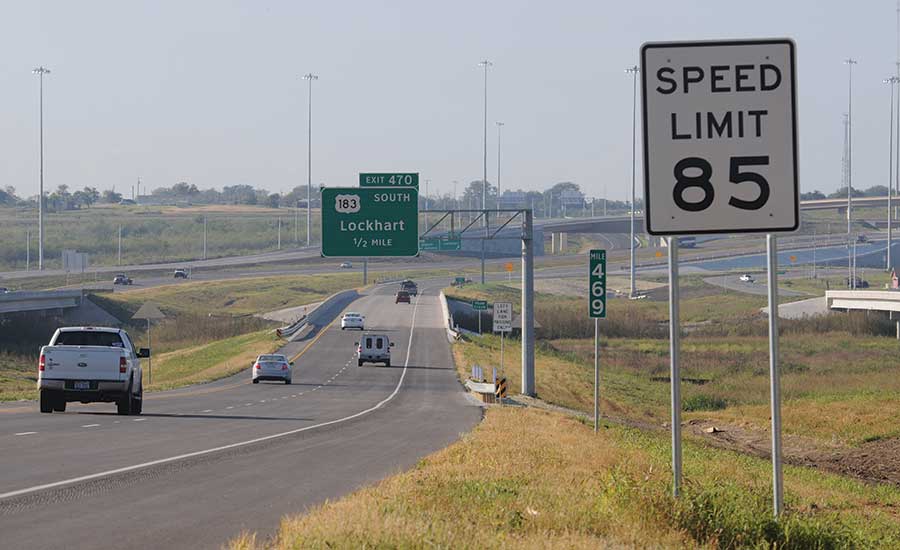Public-Private Partnerships
When Toll Road Traffic Flows Fall Short
Bankruptcy of Texas’ first public-private highway venture puts focus on user projections

Users Wanted Low-flow traffic levels on the 41-mile southern section of SH 130 in Texas led to a bankruptcy filing by its private-sector owner-operator, SH 130 Concession Co., and its takeover by lenders. Photo Kevin Stillman/TxDOT

Long Haul Despite an 85-mph speed limit on the 41-mile P3 portion of SH 130 between Austin and San Antonio, many truckers sought cheaper travel alternatives. Map illustration by Kaela Torres/ENR

No Go Despite enhancements to users, Virginia’s Pocahontas Parkway was not a financial success as a private toll-road venture, dating to the early 2000s. Photo by Tom Saunders, VDOT



The bankruptcy of the first public-private highway venture in Texas has put a new focus on the inexact science of traffic-flow projections. Even as the private-sector concessionaires of the state Highway 130 sections in default have turned over ownership to lenders, the debate over the risks of toll-road revenue forecasting will continue in Texas—and elsewhere.
SH 130 Concession Co., operators of the 41-mile southern section of the state-owned Highway 130 toll road between Austin and San Antonio, earlier this year filed for Chapter 11 protection in U.S. Bankruptcy Court in San Antonio, with a reported debt of more than $1.6 billion.
The company is owned by the U.S. arm of Spanish infrastructure developer Cintra and San Antonio-based Zachry American Infrastructure, which built the $1.3-billion extension to the Texas Dept. of Transportation’s existing 49-mile toll road. The concession agreement gave the company a 50-year operations-and-maintenance lease on the new section, with TxDOT retaining ownership and a portion of the annual toll revenue.
Despite the lure of an 85-mph speed limit on Highway 130 since its 2012 completion, motorists—particularly long-haul truckers—have tended to stick with the free lanes of I-35, located 30 miles to the west, despite frequent congestion. Signs of trouble appeared early, as credit-rating agencies downgraded SH 130 Concession Co. debt after only one year of operation and warned investors of potential default.
In a restructuring plan filed in early August, lenders will take over company interests held by Cintra and Zachry and continue operating the highway. Court approval of the plan could come within 90 days, says the company.
While SH 130 Concession Co. declined to provide the source and specifics of project traffic forecasts, Chief Operations Officer Guy Russell linked the P3 segment’s low volumes to its opening after the recession. “The sharp decrease in economic activity reduced traffic congestion on I-35, thereby reducing the need for motorists to pay for using the tollway as a traffic by-pass,” Russell said via email.
TxDOT spokesman David Glessner says that while the agency could not comment on SH 130 Concession Co. forecasting methods, the state owned-and- operated section, completed in 2008, is “doing well.”
Traffic on the P3 segment increased by 14.5% in the first six months of 2016 compared to the same period in 2015, according to SH 130 Concession Co.
SH 130’s disappointing traffic and revenue performance is consistent with other toll projects that have involved private financing, according to researchers. Studies have found new toll road traffic and revenue forecasts were overestimated by as much as 30%, due in part to shortcomings in projections from both consultants and financial-sector analysts.
One frequently cited source of excessive optimism is the predicted number of truckers willing to pay a premium toll for reduced congestion and time savings on routes.
Yet, a 2015 analysis of truck incentives for the northern section of SH 130 by Texas A&M University’s Transportation Institute found that independent drivers and owner-operators, who comprise 99% of the state trucking industry, did not see value in the toll road’s purported benefits.
“Often, those costs are coming out of their own pocket,” explains Mark Burris, an associate head of the school’s civil engineering department. That includes the toll itself and the added expense of driving a large truck at higher speeds. Because many drivers have wide time windows to reach their destinations, “saving five to 10 minutes doesn’t mean much,” he adds.
SH 130 is not the first under- performing P3 toll road to end up in bankruptcy.
The Virginia Dept. of Transportation’s initial effort, the 9-mile Pocahontas Parkway in Richmond, failed to attract users after its 2002 opening, with news accounts citing lack of development in the city’s eastern suburbs.
Developers Fluor Daniel and the former Morrison Knudsen surrendered its operation in 2004, with Australia’s Transurban buying a 99-year O&M concession from VDOT for $611 million. Despite adding a connector to Richmond International Airport, Transurban barely covered its costs during six years of oversight that ended in 2013. The firm gave up operational ownership to the project’s European bank creditors. Infrasructure operator DBi Services assumed its operation in 2014.
A recession-linked drop in truck traffic was blamed for the 2014 bankruptcy filing by the Indiana Toll Road concession, which bid $3.8 billion in 2006 for a 75-year lease to operate the 157-mile toll road. IFM Investors bought the lease’s remaining 66 years for $5.7 billion in 2015.
John Parkinson, executive director of the P3 advocacy group Association for the Improvement of American Infrastructure, doubts the bankruptcies will have a chilling effect on investors’ interest in future projects.
“There are more analogous P3 projects by which investors can make decisions on predictive behavior,” he says, pointing to developing projects in Colorado, Illinois and Virginia as evidence of private-sector appetite. “Even with the bankruptcies, the roads themselves remain safe and operational—at no risk to taxpayers,” he says. But rather than using P3s on all-new routes such as SH 130, Parkinson sees them augmenting existing highway networks with managed express lanes. “We’re also seeing more projects that use availability payments, as opposed to the straight revenue model,” he says.
John Porcari, president of U.S. advisory services for WSP/Parsons Brinckerhoff, says, “Properly structured toll-based public-private partnerships … will continue to be an important tool” for U.S. highway infrastructure.
Even so, enthusiasm for P3s appears to have waned in Texas. Last year, the state Legislature adjourned without approving any new comprehensive toll-project deals, the first such occurrence since 2007. But Glessner says, “If alternatives such as P3 are found to be the best approach, [TxDOT] will consider their use.”
Virginia has restructured its P3 approach, seeking to eliminate risk transparency that helped to doom a proposed 55-mile tolled parallel highway to U.S. Route 460, a project similar to SH 130, given its competition with an existing parallel route and reliance on truck revenue.
VDOT spokeswoman Tamara Rollison says the reformed process already has increased competition and minimized taxpayer risk for a $2.1-billion express-lanes project on I-66 in northern Virginia. “To make sure the state is in a good position of strength in negotiations, we are keeping a public financing option on the table until a contract is signed,” she adds.
While P3 participants strive to minimize risks, Parkinson says, there always will be an uncontrollable uncertainty, particularly with concession deals lasting up to a century.
“It’s like any other kind of investment,” he says. “The more information you can find to refine your model, the better decisions you can make.”
While, in Australia, forecasting issues have been at the core of recent P3 project litigation that has caused some consultants, including PB, to stop providing modeling services there, the firm continues to offer them to U.S. clients, says Porcari.
Traffic forecasting techniques have grown in sensitivity and sophistication to provide those answers, but Burris says every study still comes with its own list of caveats, from economic shifts to motorist behavior. “We still are not capturing everything, but we’re getting better and better at finding reasonable answers,” he concedes.








